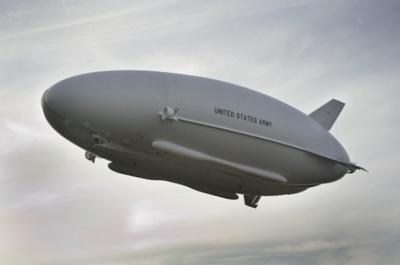Fri, Aug 10, 2012
Medium-Altitude-Long-Endurance Lighter-Than-Air Aircraft Can Operate Manned Or Unmanned
In its first flight, the Army's hybrid air vehicle known as the Long Endurance Multi-Intelligence Vehicle, or LEMV, stayed aloft over Joint Base McGuire-Dix-Lakehurst, NJ, for more than 90 minutes on August 7. The LEMV, like a blimp, is capable of carrying multiple intelligence, surveillance and reconnaissance payloads for more than 21 days at altitudes greater than 22,000 feet. The U.S. Army Space and Missile Defense Command/Army Forces Strategic Command conducted the first flight test of vehicle.

"Murphy Bays" on the LEMV can carry just about any kind of sensor or equipment, and design specifications for the LEMV require the vehicle to provide up to 16 kilowatts of electrical power for those payloads. The LEMV is intended to be used to conduct long-term Intelligence, Surveillance, and Reconnaissance, or ISR, and persistent stare-type missions, and can also be used as a communications relay.
The primary objective of the first flight was to perform a safe launch and recovery of the LEMV. A secondary goal was to verify the flight control system operation. Additional objectives included airworthiness testing and demonstration, as well as system-level performance verification. All objectives were met during the first flight.
The football field-sized LEMV can operate at altitudes greater than 22,000 feet above mean sea level, has a 2,000 mile radius of action, can carry a 2,750 pound ISR payload for more than 21 days, and boasts a fuel consumption that is more than 10 times less than comparable capabilities. Design requirements for the LEMV include providing up to 16 kilowatts of electrical power for payload, as well as runway independence.
The LEMV is designed to be a recoverable and reusable multi-mission platform. It can be forward located to support extended geostationary operations from austere locations and capable of beyond-line-of-sight command and control. During this first flight, the LEMV was manned, though the air vehicle can also operate unmanned.
Following a planned and detailed inspection of the vehicle, there will be additional manned flights.
(Image provided by the U.S. Army)
More News
From 2023 (YouTube Version): Legacy of a Titan Robert (Bob) Anderson Hoover was a fighter pilot, test pilot, flight instructor, and air show superstar. More so, Bob Hoover was an i>[...]
Get The Latest in Aviation News NOW on Instagram Are you on Instagram yet? It's been around for a few years, quietly picking up traction mostly thanks to everybody's new obsession >[...]
Aero Linx: B-52H Stratofortress The B-52H Stratofortress is a long-range, heavy bomber that can perform a variety of missions. The bomber is capable of flying at high subsonic spee>[...]
Altimeter Setting The barometric pressure reading used to adjust a pressure altimeter for variations in existing atmospheric pressure or to the standard altimeter setting (29.92).>[...]
"Knowing that we play an active part in bettering people's lives is extremely rewarding. My team and I are very thankful for the opportunity to be here and to help in any way we ca>[...]
 Classic Aero-TV: Remembering Bob Hoover
Classic Aero-TV: Remembering Bob Hoover ANN FAQ: Follow Us On Instagram!
ANN FAQ: Follow Us On Instagram! ANN's Daily Aero-Linx (05.15.24)
ANN's Daily Aero-Linx (05.15.24) ANN's Daily Aero-Term (05.15.24):Altimeter Setting
ANN's Daily Aero-Term (05.15.24):Altimeter Setting Aero-News: Quote of the Day (05.16.24)
Aero-News: Quote of the Day (05.16.24)



